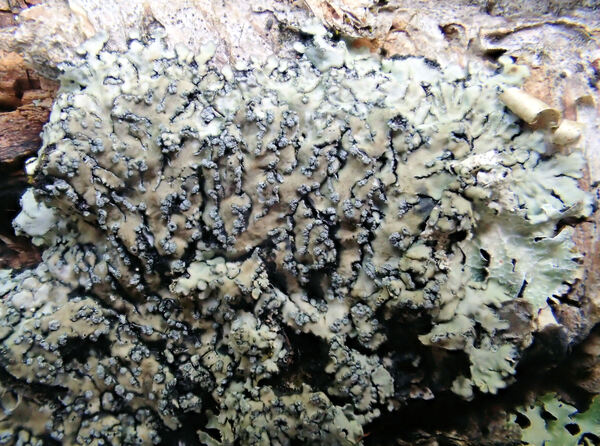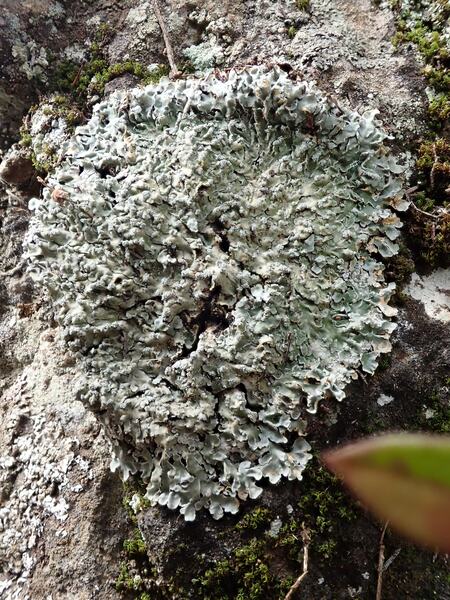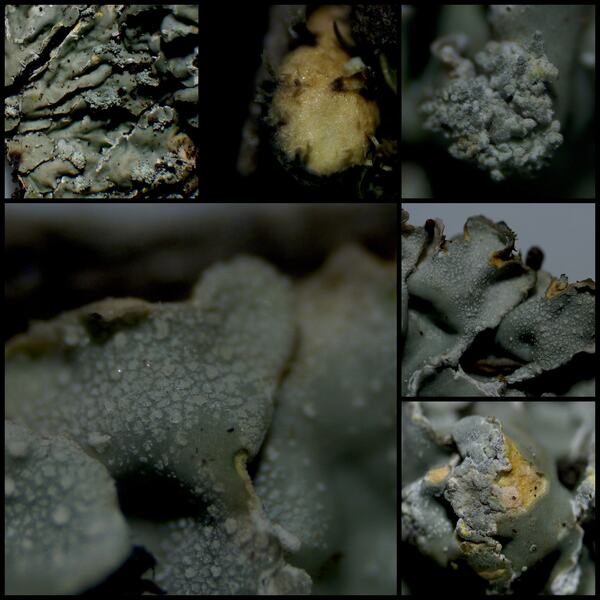Pyxine sorediata (Ach.) Mont.
in Sagra, Hist. Physc. Cuba, Bot. Pl. Cell., 9: 188, 1842. Basionym: Lecidea sorediata Ach. - Syn. Meth. Lich.: 54, 1814.
Synonyms: Physcia endochrysoides Nyl.; Pyxine endochrysoides (Nyl.) Degel.
Distribution: C - Laz.
Description: Thallus foliose, heteromerous, dorsiventral, rather loosely attached, sorediate, forming orbicular, 3-5(-8) cm wide rosettes. Lobes flat to slightly concave, 0.5-1(-1.3) mm wide, grey to brownish grey, usually darker towards the margins, with slightly pruinose spots at tips (the pruina not forming distict patches), with a well-evident network of laminal, linear pseudocyphellae contrasting with the dark lobe margins. Soralia initially marginal, fissural, later laminal, orbicular, convex, with dark grey, granulose soredia. Lower surface black in central parts, paler at margins, with black, furcate rhizines. Upper cortex paraplectenchymatous; medulla lemon-yellow at least in upper part; lower cortex prosoplectenchymatous. Apothecia lecideine, very rare (not seen in Italian material), laminal, 0.3-1.5 mm across, with a black, epruinose disc, without a distinct thalline margin. Internal stipe distinct, brownish-red and K+ purple in upper part, white and K- in lower part; proper exciple blackened; epithecium bluish black, K+ purple; hymenium colourless; paraphyses capitate; hypothecium brown. Asci 8-spored, clavate, Bacidia-type. Ascospores 1-septate, brown, ellipsoid, 13-19 x 6-8 µm. Pycnidia black, immersed. Conidia bacilliform, 3-4 x c. 1 µm. Photobiont chlorococcoid. Spot tests: upper cortex K+ yellow or K-, C-, KC-, P- or P+ faintly yellow; medulla K-, C-, KC-, P-, UV-; uper part of the internal stipe of apothecia K+ purple-red, KC+ purple. Chemistry: upper cortex with often low amounts of atranorin; medulla with terpenes and an unknown pigment.Note: a subtropical species occurring both on bark (rarely) and on siliceous rocks. The species, which was considered as a pre-glacial relict in Europe by Masson (2008), is certainly very rare in Italy.
Growth form: Foliose, narrow lobed
Substrata: bark and rocks
Photobiont: green algae other than Trentepohlia
Reproductive strategy: mainly asexual, by soredia, or soredia-like structures (e.g. blastidia)
Restricted to humid-warm, oceanic areas
Commonnes-rarity: (info)
Alpine belt: absent
Subalpine belt: absent
Oromediterranean belt: absent
Montane belt: absent
Submediterranean belt: absent
Padanian area: absent
Humid submediterranean belt: absent
Humid mediterranean belt: extremely rare
Dry mediterranean belt: absent
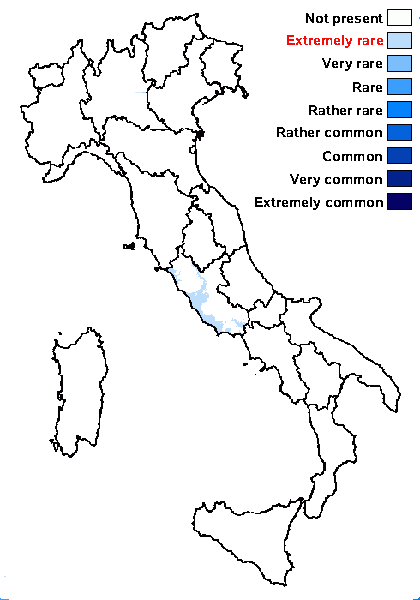
Predictive model
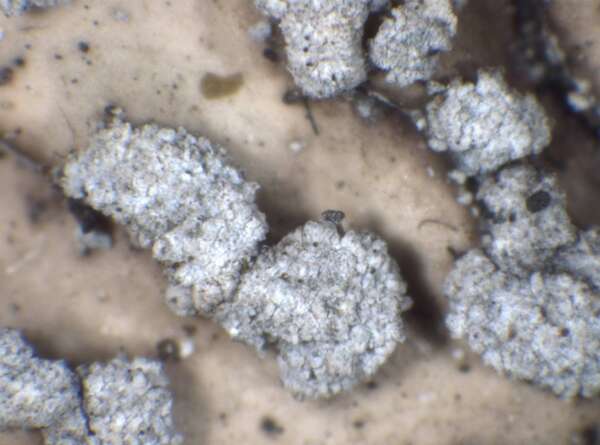

P.L. Nimis; Owner: Department of Life Sciences, University of Trieste
Herbarium: TSB (15967)
2003/03/12
detail of old soralia


P.L. Nimis; Owner: Department of Life Sciences, University of Trieste
Herbarium: TSB (15967)
2003/03/12
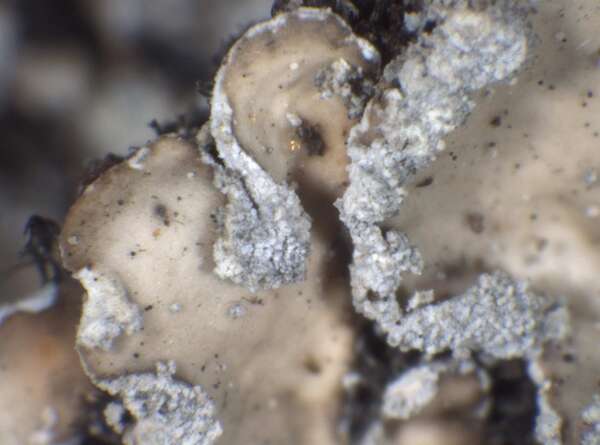

P.L. Nimis; Owner: Department of Life Sciences, University of Trieste
Herbarium: TSB (15967)
2003/03/12
detail of young soralia
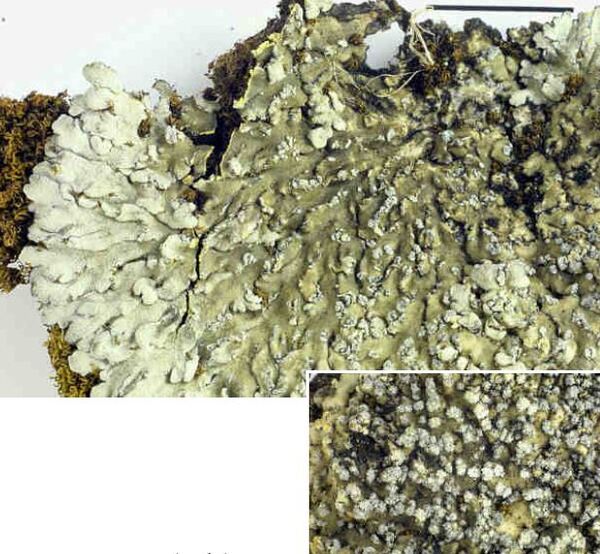

Felix Schumm – CC BY-SA 4.0
Image from: F. Schumm (2008) - Flechten Madeiras, der Kanaren und Azoren. Beck, OHG - ISBN: 978-3-00-023700-3
Growth form: Foliose, narrow lobed
Substrata: bark and rocks
Photobiont: green algae other than Trentepohlia
Reproductive strategy: mainly asexual, by soredia, or soredia-like structures (e.g. blastidia)
Restricted to humid-warm, oceanic areas
Commonnes-rarity: (info)
Alpine belt: absent
Subalpine belt: absent
Oromediterranean belt: absent
Montane belt: absent
Submediterranean belt: absent
Padanian area: absent
Humid submediterranean belt: absent
Humid mediterranean belt: extremely rare
Dry mediterranean belt: absent

Predictive model


P.L. Nimis; Owner: Department of Life Sciences, University of Trieste
Herbarium: TSB (15967)
2003/03/12
detail of old soralia


P.L. Nimis; Owner: Department of Life Sciences, University of Trieste
Herbarium: TSB (15967)
2003/03/12


P.L. Nimis; Owner: Department of Life Sciences, University of Trieste
Herbarium: TSB (15967)
2003/03/12
detail of young soralia


 INDEX FUNGORUM
INDEX FUNGORUM
 GBIF
GBIF
